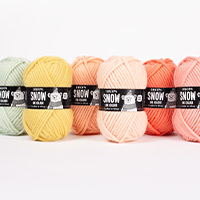How to change yarns or yarn amounts
Changing

1 strand of yarn for another:
If the yarn gives the same knitting gauge it is easy to change from one to the other.
Follow the given knitting gauge in the pattern – remember needle size is only a guide; change to the needle size you need. For more info on knitting gauge, see here
Be aware: When changing yarns, the amount of yarn might also need adjusting, because the meterage of yarn in a ball (50 gram = X metres) varies from yarn to yarn - see the calculation below.

1 strand within a yarn group:
All our yarns are spun to standard thickness and can be used for the same pattern if you change within the one DROPS Yarn group. See our yarn groups here.
Different yarns have different structures.
Be aware: When changing yarns, the amount of yarn might also need adjusting, because the meterage of yarn in a ball (50 gram = X metres) varies from yarn to yarn - see the calculation below.

1 strand of yarn to 2 or more strands:
DROPS yarns are spun so the thickness of the strands fit each other.
By working with more than one strand from one Yarn Group, you can easily find patterns in other Yarn Groups (see yarn groups here) or see our suggestions (see recommended yarn combinations here).
Be aware: When changing yarns, the amount of yarn might also need adjusting because the meterage of yarn in a ball (50 gram = X metres) varies from yarn to yarn - see the calculation below.
Here is a list of yarns which can easily be exchanged between Yarn Groups:
| Yarn Group A | 2 strands | = | 1 strand | Yarn Group C |
| Yarn Group A | 3 strands | = | 1 strand | Yarn Group D |
| Yarn Group A | 4 strands | = | 1 strand | Yarn Group E |
| Yarn Group A | 8 strands | = | 1 strand | Yarn Group F |
| Yarn Group B | 2 strands | = | 1 strand | Yarn Group D |
| Yarn Group C | 2 strands | = | 1 strand | Yarn Group E |
| Yarn Group C | 4 strands | = | 1 strand | Yarn Group F |
| Yarn Group E | 2 strands | = | 1 strand | Yarn Group F |
In DROPS patterns this is written as: A + A = C
The amount of yarn is adjusted when changing:
1 strand for 1 strand.
When changing yarns, the amount of yarn might also need adjusting, because the meterage of yarn in a ball (50 gram = X metres) varies from yarn to yarn - see the calculation below:
In the pattern you need 300 g Yarn-X
We need the meterage to be able to calculate how much Yarn-Y you need:
Yarn-X: 50 g = 170 metres = 186 yards
Total yarn required: 6 balls x 170 metres = 1020 metres = 1115 yards
Yarn-Y: 50 g = 150 metres = 164
Number of metres of Yarn-X = 1020 metres = 1115 yards
divided by the number of metres Yarn-Y = 6.8 balls
Result:
7 balls = 350 g of Yarn-Y
replaces
6 balls = 300 g of Yarn-X.
Need help to do the sums? Try our calculator!
1 strand for 2 strands with the same meterage.
This is an example, to show you how you calculate the yarn needed when changing from 1 strand DROPS Snow (Yarn Group E) to 2 strands DROPS Air (Yarn Group C) - see calculation below:
The pattern states 1150 g DROPS Snow.
We need the meterage to be able to recalculate:
DROPS Snow: 50 g = 50 metres = 54 yards
Total yarn required: 23 balls x 50 metres = 1150 metres = 1 257 yards
DROPS Air: 50 g = approx. 150 metres = 164 yards
Number of metres of DROPS Snow = 1150 metres = 1 258 yards
divided by number of metres of DROPS Air = 7.67 balls
You are going to work with 2 strands instead of 1 strand, therefore the number of balls is x 2: 7.67 x 2 = 16 balls
Result:
1150 g DROPS Snow
is replaced by
800 g DROPS Air
Need help to do the sums ? Try our calculator!
2 strands of different meterage to 1 strand.
This is how to calculate the yarn needed when you wish to work with 1 strand in a pattern which uses 2 strands
Example: 1 strand DROPS BabyAlpaca Silk (from Yarn Group A) and 1 strand DROPS Kid-Silk (from Yarn Group A)
is changed to:
1 strand DROPS AIR (from Yarn Group C)
The pattern states:
300 g DROPS BabyAlpaca-Silk and 125 g DROPS Kid-Silk
(= 2 strands from Yarn Group A)
Re-calculate this to:
1 strand DROPS Air (Yarn Group C)
We need the meterage to be able to re-calculate:
DROPS BabyAlpaca-Silk: 50 g = 167 metres = 183 yards,
Total yarn required: 6 balls x 167 metres = 1002 metres = 1 096 yards
DROPS Kid-Silk: 25 g = 200 metres = 218 yards
Total yarn required: 5 balls x 200 metres = 1000 metres = 1 093 yards
Alternative new yarn:
DROPS AIR: 50 g = 150 metres = 164 yards
Begin with the yarn with the shortest meterage = 1000 metres = 1093 yards
Divide by the number of metres of DROPS Air:
1000 metres divided by 150 metres = 1093 yards divided by 164 yards = 6.7 balls; so 7 balls
Result:
300 g DROPS BabyAlpaca-Silk
125 g DROPS Kid-Silk
is replaced by:
350 g DROPS Air













Gosta multi de trabalhos com lâ Drops
22.10.2015 - 15:31: